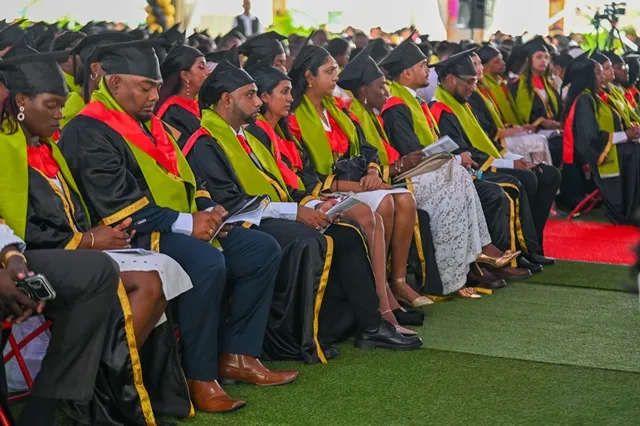Introduction: A Country in Motion
For decades, Guyana’s geography has been both a blessing and a curse. Vast rivers and unforgiving jungles separated communities; a simple trip from Lethem in the south to Georgetown could take days over muddy trails. The Demerara River, a lifeline, had an aging floating bridge that regularly snarled traffic. This was Guyana – rich in land, poor in connectivity. But step into 2025, and the scene is transforming at a dizzying pace. Cranes dominate skylines where new bridges rise, asphalt ribbons unspool through the interior, and ferries and planes chart new routes. In short, Guyana is undergoing a transport revolution, stitching together a once fragmented land.
At the heart of this push is a recognition: to truly benefit from economic boom, people and goods must move faster and cheaper. The current PPP/C government has embraced infrastructure as the backbone of inclusive growth – pouring oil revenue and loans alike into roads, bridges, ports, and airports. This is not just pouring concrete; it’s building unity and opportunity. A farmer in Berbice can now envision sending produce to a market across the border in Suriname via a future bridge, and an Indigenous artisan in Region 1 might reach Georgetown’s craft market in hours instead of a day.
Let’s journey through Guyana’s major transport projects – each a story of engineering, diplomacy, and development – and see how they collectively propel the nation forward.
The New Demerara Bridge: Ending the Bottleneck
Perhaps no single piece of infrastructure is more anticipated than the New Demerara River Bridge. The current Demerara Harbour Bridge, built in 1978, is a floating pontoon structure – the only pathway connecting the capital and populous Region 4 with the fast-growing Region 3. It’s infamous for daily traffic jams and occasional malfunctions that literally cut the country in half for hours. Enter the solution: a modern four-lane, high-span fixed bridge slated to be completed by August 31, 2025.
This bridge is a game-changer. No more scheduled openings halting traffic for ships, no weight limits preventing heavy trucks from crossing. It will be high enough for vessels to pass freely, with four lanes ensuring smooth flow. Already, by January 2025, it was about 62% completed. The engineering is impressive – massive concrete piers, a span of several kilometers, all built to last 100 years. The project did face a slight delay (pushing from March to August 2025 due to concrete curing time), but compared to the decades of talk with no action, a few months is trivial.
The significance goes beyond easing commutes. The new Demerara bridge is a linchpin for the oil and gas sector’s logistics. As service companies set up on the western bank (at Nismes and Vreed-en-Hoop), a reliable crossing is essential to ferry workers and equipment. It’s also integral to the forthcoming Wales Gas-to-Energy plant just upriver – heavy machinery will be moved over this bridge. Planners expect an economic blossoming along its approach roads: warehouses, housing schemes, shops – imagine the kind of development that highways usually spur.
From a citizen’s perspective, the bridge represents relief and pride. Relief that a daily ordeal will end; pride that Guyana can finally boast infrastructure on par with developed nations. It also has a unifying psychological effect: people on opposite sides of the river feel less separated. Regions 3 and 4 will practically merge into one economic zone. And aesthetically, a sleek bridge soaring over the Demerara is set to become an iconic landmark – a concrete symbol of Guyana’s rise.
Linden to Lethem Highway: Opening the Hinterland
If the Demerara Bridge binds the coast, the Linden to Lethem road opens the hinterland. This project is, in some ways, even more transformative. We’re talking about converting a rough laterite trail into a paved highway stretching over 450 km from Linden (south of Georgetown) to Lethem on the Brazilian border – effectively connecting the Atlantic port to the vast savannah interior and further to northern Brazil.
The first segment, Linden to Mabura Hill (122 km), is under active construction and is now targeted for completion by October 29, 2025. It’s a US$190 million undertaking co-financed by the Caribbean Development Bank, the UK (providing its largest ever grant to Guyana at £50 million) and the Guyanese government. By January 2025, it was about one-third complete, with some delays due to material procurement issues causing a few months’ pause. But work resumed, and progress is accelerating.
This highway will be a two-lane asphalt road with modern specs – 7.2m wide carriageway, 2m shoulders, and even bus stops with disabled-friendly ramps. Importantly, numerous bridges are being upgraded from wooden to concrete, and a bridge over the Essequibo River at Kurupukari is planned to replace the aging ferry there. When finished, a truck or bus from Georgetown should reach Lethem in perhaps 8–10 hours instead of the unpredictable 24-48 hours currently.
Why does this matter? Because Guyana’s vast interior – rich in minerals, timber, cattle, and tourism potential – has been hamstrung by poor access. The road will slash transportation costs, making it viable to bring cassava flour, peanuts, beef, and other Rupununi products to coastal markets. It also means cheaper goods flowing the other way, lowering cost of living for hinterland residents. Furthermore, Brazil’s northern state of Roraima (bordering Guyana) is landlocked and relatively underdeveloped; a road linking to a Guyanese deepwater port gives them an Atlantic outlet. Already there’s talk of Lethem becoming a bustling trade hub – warehouses, trucking depots, etc. The highway will integrate Guyana’s economy with Brazil’s, unlocking trade beyond imagination.
Diplomatically, it cements Guyana’s western interior, asserting presence in a region historically neglected (and in proximity to Venezuela’s border claims, though the highway is far from that). Socially, it brings services – emergency healthcare access, for instance. A pregnant woman in a village along the route would no longer have to fly out in a tiny plane for complications; an ambulance could feasibly reach.
The government touts this as part of bridging the gap between coastland and hinterland – a literal gap in this case. It aligns with the One Guyana mantra: no part of the country should remain isolated. And indeed, the project has broad support (though some environmental concerns exist about opening pristine rainforest to easier exploitation – mitigations are in place through environmental management plans).
Corentyne River Bridge: Linking Neighbors and Markets
While internal connectivity is crucial, Guyana is also looking outward, especially to Suriname to the east. The Corentyne River Bridge project, to link Guyana and Suriname by road for the first time, is edging closer to reality. Plans are advanced: the bridge will be 3.1 km long, from Moleson Creek (Guyana) to South Drain (Suriname), with a mid-river stop at Long Island. On Long Island, envision a duty-free commercial hub and tourist zone – a joint initiative by the two nations to spur business.
This bridge is a big deal historically. Guyana and Suriname, despite similarities, have had limited overland exchange (relying on a small ferry). The bridge would physically unite CARICOM’s two continental members, intensifying trade, family ties, and even tourism (imagine easy weekend trips in either direction). Economically, it creates a corridor from northern Brazil all the way to French Guiana via Guyana and Suriname. This is regional integration in action – the sort of connectivity that can transform a whole area of South America’s northeast shoulder, creating a new trade route and tourism circuit.
Funding has been a sticking point: both countries agree it’s needed, but Suriname’s financial woes slowed things. Guyana, flush with funds, has signaled readiness to finance its share and possibly more. As of early 2025, multiple bids from international firms were in, and governments were working out financing models (could be a public-private partnership or joint loan).
Politically, it’s a legacy project for President Ali and Suriname’s President Santokhi, who enjoy a friendly rapport. It’s also a subtle geopolitical play: a Chinese firm involvement (likely, given Chinese bids) versus any Western financing can tilt influence. But locals care less about that than about opportunities: for instance, Guyanese vendors eye Suriname’s markets for rice and cement; Surinamese look forward to easier access to Guyana’s booming economy.
One should note this bridge’s popular support – people remember that in tough times (70s/80s) Suriname was a lifeline, and vice versa. It’s seen as a natural progression, “destined to traverse history hand-in-hand” as one commentator put it. If it breaks ground in 2025, completion could be by 2028. And when that ribbon is cut, it will herald a new era of cross-border synergy.
Modernizing Ports and Air Travel
Connectivity isn’t just roads and bridges. Guyana’s trade expansion demands modern ports. Georgetown’s harbor, shallow and silt-laden, has been a bottleneck for large ships. But here too change is afoot. At Vreed-en-Hoop (across the Demerara from Georgetown), a massive shore base port has sprung up on reclaimed land – initially serving oil operations, but designed to handle container shipping in time. Vice President Bharrat Jagdeo highlighted that this US$300 million port could provide wider shipping relief beyond oil needs. As it expands (with plans for 800 acres of facilities), Guyana might finally receive Panamax vessels directly, slashing import/export costs.
Simultaneously, a Berbice Deep Water Port near the mouths of the Berbice River is under development by a private consortium (led by CGX Energy). Though slowed by financing hiccups, it’s expected to serve agriculture and mining exports from eastern Guyana and even northern Brazil. And at the mouth of the Demerara, dredging widened the channel from 70m to 100m, allowing safer, more frequent ship movement already.
On the aviation side, Cheddi Jagan International Airport (CJIA) completed a major expansion in 2022, adding a longer runway and modern terminal. Now it handles more flights, including new direct routes to Europe (British Airways began service) and additional North American connections. Passenger throughput is rising. There’s even chatter of making CJIA a regional hub, given Guyana’s strategic position and burgeoning business travel.
Additionally, the government is upgrading hinterland airstrips – essential for interior access where roads still don’t reach. From Kamarang in Region 7 to Eteringbang near the border, many dirt strips are being lengthened and paved. Not only does this improve safety, but it allows larger aircraft (twin otters instead of tiny Cessnas) to operate, making air travel to remote areas more economical.
A noteworthy project is the new regional airports plan: transforming the modest Ogle Airport (Georgetown’s second airport) into a bigger regional hub for CARICOM flights, and possibly developing an international-standard aerodrome in Lethem eventually as cross-border traffic increases.
Urban Transport and Coastal Links
As big projects steal the limelight, smaller yet impactful improvements in urban and coastal transport are also underway. Georgetown’s roads are being upgraded, with overpasses at busy junctions, widening of the East Bank highway, and a new four-lane East Coast road extension. Minibus transport remains chaotic but efforts to formalize routing and safety standards continue.
A big quality-of-life project for the capital is the Ogle to Eccles bypass highway, which was completed easing congestion on existing roads. Now, commuting from the East Coast to the East Bank (home to many new housing schemes) avoids downtown completely. Plans to extend this bypass further west are on the table, eventually linking to the new Demerara Bridge for a ring-road effect around Georgetown.
On the coast, the Sea Dam road linking villages is steadily improving, and new river bridges within regions (like the one over the Puruni River in Region 7, or the Wismar bridge in Linden) help local connectivity.
The government also invested in new ferries for riverine and coastal communities. The MV Ma Lisha, a ferry gifted by India, launched in 2023, now serves the North West District (Region 1) – cutting what was a long overnight boat journey into a safer, more comfortable ride, connecting indigenous communities to the mainland. Similarly, repairs to the Bartica ferry stelling and new speedboats for Essequibo Islands show attention to those who rely on waterways daily.
Challenges: From Asphalt to Sustainability
Building is one thing; maintaining is another. Guyana has historically struggled with maintenance – potholes and derelict bridges often followed a few years of neglect. The current administration claims it’s factoring this in by allocating funds for maintenance and strengthening agencies like the Public Works Ministry. Only time will tell if new assets remain in good shape. The influx of financing (loans and oil money) must be managed prudently to avoid debt pitfalls; fortunately, many projects are outright funded or grant-assisted (like the UK’s grant for Linden road), which mitigates risk.
Another challenge is ensuring local communities benefit and aren’t bypassed. A highway can also mean speeding trucks endangering wildlife or children, or outsiders coming in and not hiring locals. The Linden-Lethem project, for instance, mandated local employment and training. There’s also environmental monitoring, as the road cuts through sensitive ecosystems. So far, early signs are that wildlife corridors and drainage are being addressed.
A subtle issue is land and settlement: better transport tends to increase land value. There are concerns of land speculations near new infrastructure – the government has to be vigilant to prevent unscrupulous acquisition or displacement of small landowners. In Berbice, for instance, people are already eyeing land near the expected landing of the Corentyne Bridge, anticipating a boom.

Unity and Growth on the Road Ahead
Why is all this so crucial? Because infrastructure knits the country together in ways social programs or cash transfers alone cannot. It provides the skeleton on which the flesh of an economy and society can grow. The PPP/C government often references the glory days of the 60s/70s when infrastructure like the first Demerara bridge and Soesdyke-Linden highway were built, and laments the stagnation in later decades. Now they have the resources and mandate to catch up and even leapfrog.
Already, ordinary Guyanese feel the change: A trip that took 3 hours now takes 1 on a new four-lane stretch; produce that rotted for lack of transport now reaches market fresh; relatives separated by rivers visit more often. These are real impacts on daily life. For example, the Mahaica to Mahaicony road upgrade meant flood-prone communities on the East Coast remain accessible year-round – critical during flooding seasons.
Transport is also bridging Guyana’s ethnic and regional divides in a literal sense. Historically, Indo-Guyanese dominated certain coastal farming areas while Afro-Guyanese were more urban or hinterland-based, and Indigenous people isolated in the interior. By connecting these regions, cultures mix more. An Indigenous family might drive to the capital and interact more with the rest of society; a coastal trader might drive inland to do business with a Macushi community. Greater interaction can foster understanding – a social cohesion byproduct.
From an economic lens, improved logistics lowers costs of development projects themselves (cheaper to move construction materials), thus making housing and other infrastructure cheaper to deliver. It feeds into a virtuous cycle of development.
Conclusion: Highways to the Future
As I travel these emerging highways and cross these new bridges, what strikes me is the sense of national confidence they exude. Guyana is no longer content being the country where a broken bridge or impassable road is just shrugged off as normal. There’s a palpable expectation now that first-class infrastructure is part of Guyana’s future. People point at construction sites and tell their children – “That’s for you, so you won’t have to endure what we did.”
Of course, potholes will still appear, and traffic won’t vanish. But a connected Guyana – coast to hinterland, village to village, nation to neighbor – is a fundamentally stronger Guyana. It’s one where opportunities spread and multiply. We often speak of bridging divides metaphorically; in Guyana’s case, they are doing it concretely with steel and asphalt.
A few years from now, one might drive seamlessly from Paramaribo (Suriname) across the Corentyne bridge, zip along smooth highways through rice fields and rainforest, cross the Demerara on a majestic span, and continue all the way to Boa Vista in Brazil – all on reliable roads. Such a journey would have sounded like science fiction to an earlier generation. But it’s on the cusp of reality, driven by vision and petro-dollars put to productive use.
One must credit the current leadership for fast-tracking what previous governments only talked about. Yet it’s also the people’s victory – through patience and advocacy, they made infrastructure a national priority. As a journalist, I’ve seen how a single new road can ignite hope in a community. Multiply that by a dozen projects, and you have a country on the move, literally and figuratively.
So the next time you hear of Guyana’s oil boom, remember this: it’s not just about wealth under the sea, but about bridges over waters and roads through forests. It’s about a nation ensuring that prosperity travels to every corner. Guyana’s destiny is now firmly tied to these highways to the future – and the journey has only just begun.




